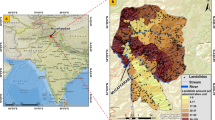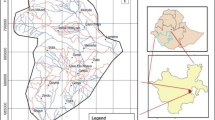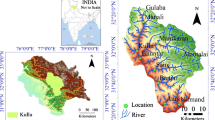Abstract
Landslide risk assessment (LRA) is a key component of landslide studies. The landslide risk can be defined as the potential for adverse consequences or loss to human population and property due to the occurrence of landslides. The LRA can be regional or site-specific in nature and is an important information for planning various developmental activities in the area. LRA is considered as a function of landslide potential (LP) and resource damage potential (RDP). The LP and RDP are typically characterized by the landslide susceptibility zonation map and the resource map (i.e., land use land cover map) of the area, respectively. Development of approaches for LRA has always been a challenge. In the present study, two approaches for LRA, one based on the concept of danger pixels and the other based on fuzzy set theory, have been developed and implemented to generate LRA maps of Darjeeling Himalayas, India. The LRA map based on the first approach indicates that 1,015 pixels of habitation and 921 pixels of road section are under risk due to landslides. The LRA map derived from fuzzy set theory based approach shows that a part of habitat area (2,496 pixels) is under very high risk due to landslides. Also, another part of habitat area and a portion of road network (7,204 pixels) are under high risk due to landslides. Thus, LRA map based on the concept of danger pixels gives the pixels under different resource categories at risk due to landslides whereas the LRA map based on the concept of fuzzy set theory further refines this result by defining the degree of severity of risk to these categories by putting these into high and low risk zones. Hence, the landslide risk assessment study carried out using two approaches in this paper can be considered in cohesion for assessing the risks due to landslides in a region.








Similar content being viewed by others
References
Acharya SK (1989) The Daling Group, its nomenclature, tectono-stratigraphy and structural grain: with notes on their possible equivalents. Geological Survey of India SPN-22:5–13
Anbalagan R, Singh B (1996) Landslide hazard and risk assessment mapping of mountainous terrains—a case study from Kumaon Himalaya, India. Engineering Geology 43:237–246
Arora MK, Das Gupta AS, Gupta RP (2004) An artificial neural network approach for landslide hazard zonation in the Bhagirathi (Ganga) Valley, Himalayas. International Journal of Remote Sensing 25(3):559–572
Boggett AD, Mapplebeck NJ, Cullen RJ (2000) South Shore Cliffs, Whitehaven—geomorphological survey and emergency cliff stabilisation works. Quaternary Journal of Engineering Geology and Hydrogeology 33:213–226
Cardinali M, Reichenbach P, Guzzetti F, Ardizzone F, Antonini G, Galli M, Cacciano M, Castellani M, Salvati P (2002) A geomorphological approach to the estimation of landslide hazards and risks in Umbria, central Italy. Natural Hazards and Earth System Sciences 2:57–72
Chau KT, Sze YL, Fung MK, Wong WY, Fong EL, Chan LCP (2004) Landslide hazard analysis for Hong Kong using landslide inventory and GIS. Computers and Geosciences 30:429–443
Ercanoglu M, Gokceoglu C (2004) Use of fuzzy relations to produce landslide susceptibility map of a landslide prone area (West Black Sea Region, Turkey). Engineering Geology 75(3&4):229–250
Fell R (1994) Landslide risk assessment and acceptable risk. Canadian Geotechnical Journal 31:261–272
Hughes A, Hewlett H, Samuels PG, Morris M, Sayers P, Moffat I, Harding A, Tedd P (2000) Risk management for UK reservoirs. Construction Industry Research and Information Association (CIRIA) C542, London
Kanungo DP, Arora MK, Sarkar S, Gupta RP (2006) A comparative study of conventional, ANN black box, fuzzy and combined neural and fuzzy weighting procedures for landslide susceptibility zonation in Darjeeling Himalayas. Engineering Geology 85(3&4):347–366
Lee EM (1999) Coastal planning and management: the impact of the 1993 Holbeck Hall Landslide, Scarborough, East Midlands. Geographer 21:78–91
Lee EM (2003) Coastal change and cliff instability: development of a framework for risk assessment and management. Unpublished PhD thesis, University of Newcastle upon Tyne
Lee EM, Clark AR (2000) The use of archive records in landslide risk assessment: historical landslide events on the Scarborough Coast, UK. In: Bromhead EN, Dixon N, Ibsen ML (eds) Landslides: in research, theory and practice. Thomas Telford, London, pp 904–910
Lee EM, Zones DKC (2004) Landslide Risk Assessment. Thomas Telford, London
Lee EM, Clark AR, Guest S (1998) An assessment of coastal landslide risk, Scarborough, UK. In: Moore D, Hungr O (eds) Engineering geology: the view from the Pacific Rim. Balkema, Rotterdam, pp 1787–1794
Leone F, Aste JP, Leroi E (1996) Vulnerability assessment of elements exposed to mass-movement: working toward a better risk perception. In: Senneset R (ed) Landslides. Balkema, Rotterdam, pp 263–269
McDonnell BA (2002) Hazard identification and visitor risk assessment at the Giant’s Causeway World Heritage Site, Ireland. In: McInnes RG, Jakeways J (eds) Instability—planning and management. Thomas Telford, London, pp 527–534
Naithani AK (1999) The Himalayan landslides. Employment News 23(47):20–26
Palmer JS, Clark AR, Cliffe D, Eade M (2002) The management of risk on the Chalk Cliffs at Brighton, UK. In: McInnes RG, Jakeways J (eds) Instability—planning and management. Thomas Telford, London, pp 355–362
Rautela P, Lakhera RC (2000) Landslide risk analysis between Giri and Tons Rivers in Himachal Himalaya (India). International Journal of Applied Earth Observation and Geoinformation (JAG) 2(3–4):153–160
Ross TJ (1995) Fuzzy logic with engineering applications. McGraw-Hill, New York
Sandilands NM, Noble M, Findlay JW (1998) Risk assessment strategies for dam based hydro schemes. In: Tedd P (ed) The prospect for reservoirs in the 21st century. Thomas Telford, London
van Dine DF, Jordan P, Boyer DC (2002) An example of risk assessment from British Columbia, Canada. In: McInnes RG, Jakeways J (eds) Instability—planning and management. Thomas Telford, London, pp 399–406
Wong HN, Ho KKS, Chan YC (1997) Assessment of consequence of landslides. In: Cruden D, Fell R (eds) Landslide risk assessment. Balkema, Rotterdam, pp 111–149
Author information
Authors and Affiliations
Corresponding author
Rights and permissions
About this article
Cite this article
Kanungo, D.P., Arora, M.K., Gupta, R.P. et al. Landslide risk assessment using concepts of danger pixels and fuzzy set theory in Darjeeling Himalayas. Landslides 5, 407–416 (2008). https://doi.org/10.1007/s10346-008-0134-3
Received:
Accepted:
Published:
Issue Date:
DOI: https://doi.org/10.1007/s10346-008-0134-3




